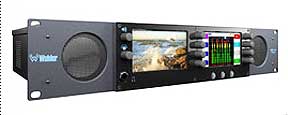Advanced Digital Broadcast (ADB) has just won two awards at the 2010 CSI Awards. ADB was awarded the Best Interactive TV Technology or Application and Best Customer Premise Technology categories with its Carbo™ HD user interface and its 5720SX three-way hybrid platform, respectively. The ADB-5720SX three-way hybrid digital TV platform was judged to demonstrate a noteworthy technological advance that enables payTV operators to seamlessly combine content from three delivery networks on a single platform and, via ADB’s Carbo user interface, make it quick and easy for consumers to access it. The ability to converge content from traditional cable/satellite, terrestrial and IP networks presents huge opportunities for the Pay-TV industry.
Empire Cinemas will deploy Arqiva’s Digital Cinema Satellite Distribution System for their entire cinema circuit. This will enable all of Empire’s 16 UK sites to electronically receive Digital Cinema Packages and live events distributed by Arqiva. Arqiva provides robust satellite and IP networks for the managed delivery of entertainment, information and advertising worldwide. The company works with leading media distributors to provide electronic delivery services of live events and feature films into digital cinemas across Europe.
Hundreds of thousands of Australians living in rural communities are currently unable to access the same free-to-air (FTA), high-quality, digital TV experience as their urban counterparts — a new five-year deal between Australia's national broadcaster, the ABC, and Ericsson (NASDAQ: ERIC) will help address this issue. Thanks to Ericsson's latest satellite video compression technology, the ABC will be able to expand the reach of its HD + SD digital TV programming across the country. As Australia undergoes the switch from analog to digital free-to-air TV, the Australian government is funding a new satellite service to provide digital television to viewers in remote areas where free-to-air digital TV can't be received by TV antennas. About 247,000 Australian households in these "digital black spots" will benefit from the initiative. The system uses a range of Ericsson head-end equipment including bandwidth-saving MPEG-4 AVC EN8190 HD and EN8130 SD encoders, Reflex statistical multiplexing for channel bitrate allocation and management, and nCompass Control and Monitoring. Managing bandwidth and maintaining high-quality pictures is critical in such a major digital TV rollout. Deployment of the technology will start in December 2010.
GlobeCast has reached agreements with several post-production and digital media service companies in America, Asia, and Europe that will allow existing and future clients to connect the post-production aspect of their workflows with the company’s Media Asset Management and delivery services, effectively becoming part of a "Digital Ecosystem." SDI Media Group, Bigfoot Entertainment, Broadway Video Digital Media, Medi-LAN, Infinite Frameworks, re:fine, TVT, and Éclair-Télétota are the first providers to have agreed to connect with GlobeCast — many more are currently in discussion with the content management and delivery company. The immediate benefit to content creators and broadcasters is the ability to streamline processes and workflows. A client working on aspects of their post-production with providers in GlobeCast’s Digital Ecosystem can now connect editors at those facilities to GlobeCast’s Media Asset Management platform to easily, quickly and very cost-effectively create regional versions of content at playout centers around the world. This is done using either fiber links or advanced file transfer programs, such as GlobeCast Content Exchange. The creation of this Digital Ecosystem involved interconnecting GlobeCast’s playout centers in Singapore, London, Miami and Paris via the company’s fiber network - the GlobeCast Backbone Network. The connection of these facilities means that clients can seamlessly ingest content in one part of the world, and playout regionalized versions of the content on multiple platforms in another part of the world. Along the way, using NETIA’s Content Management System, the content can also be archived for future use or transcoded for distribution to multiple platforms (VoD, Broadband/Web TV, Mobile TV, and so on).
Miranda Technologies has started volume shipping of its NVISION 8500 Hybrid embedded audio routers with integrated audio processing, which significantly streamline television infrastructures and eliminate video/audio timing issues. Miranda’s NVISION 8500 Hybrid router (3D/3Gbps/HD) integrates de-embedding, shuffling, break-away and re-embedding in a single frame. This means that everyday signal processing tasks, like swapping program audio tracks, can now be handled simply and elegantly within the router frame.
SIS LIVE is upgrading its satellite news gathering (SNG) network to iDirect’s Evolution platform. The upgrade allows SIS LIVE to more efficiently allocate and segment bandwidth for its leading UK broadcast customers who use the network to transmit live video and audio feeds from vehicles in the field. SIS LIVE’s network provides major UK news agencies with broadband access via satellite connectivity to help them meet the growing demand for live news coverage. Field journalists use the network to establish live broadcasts and transmit high-quality video and audio content. The network also enables ‘store-and-forward’, in which large video files are captured and edited locally, before being transmitted over the network. iDirect’s Evolution platform reliably supports these bandwidth-intense applications as well as Internet connectivity and Voice over IP (VoIP). Built on the next-generation DVB-S2 broadcasting standard with Adaptive Coding and Modulation (ACM), Evolution enables SiS LIVE to share bandwidth efficiently across multiple customer networks and maximize capacity from a limited satellite space segment. In addition, iDirect’s built-in Group Quality of Service feature makes it possible to designate bandwidth priorities at the application level. This is critical for broadcasters with multiple vehicles in the field, some of which are transmitting live video or audio.







